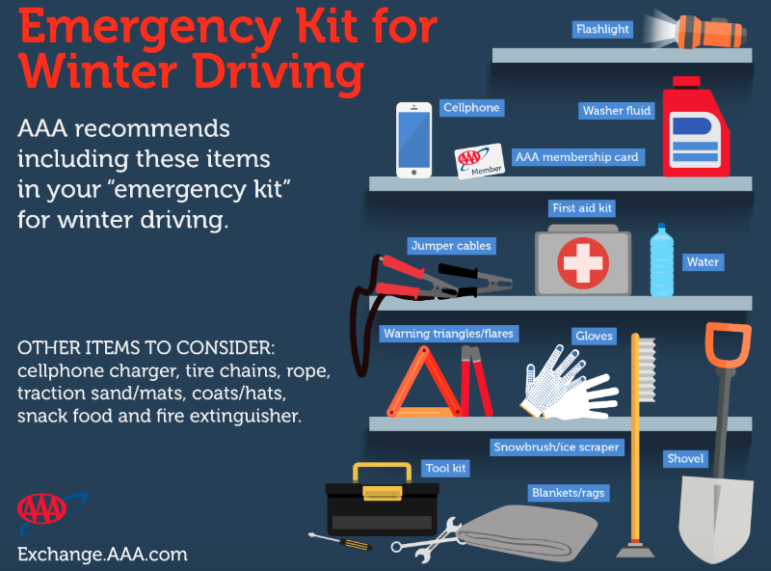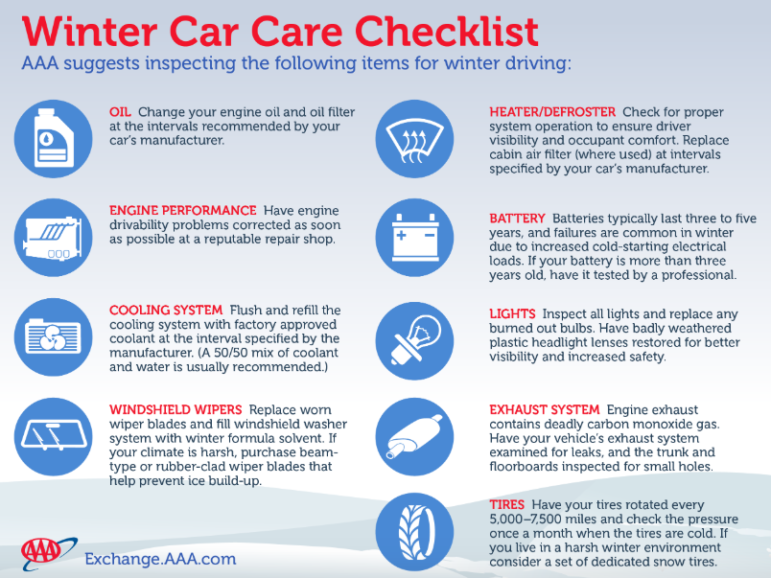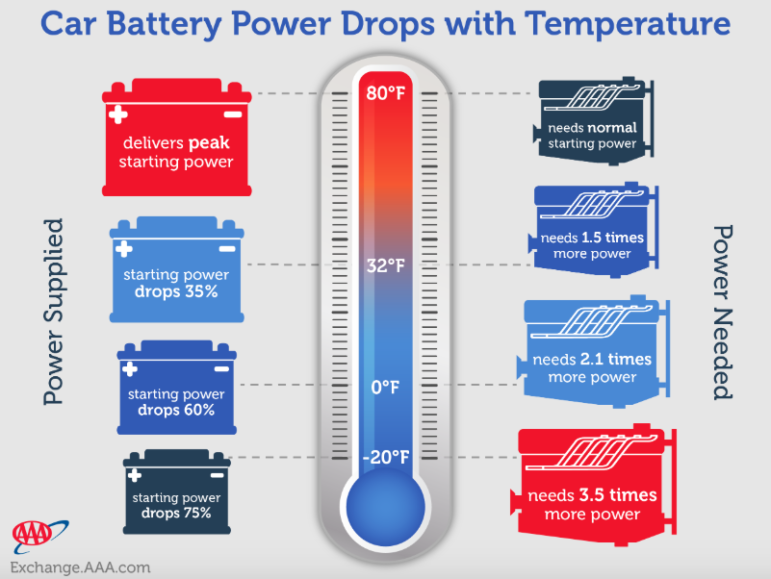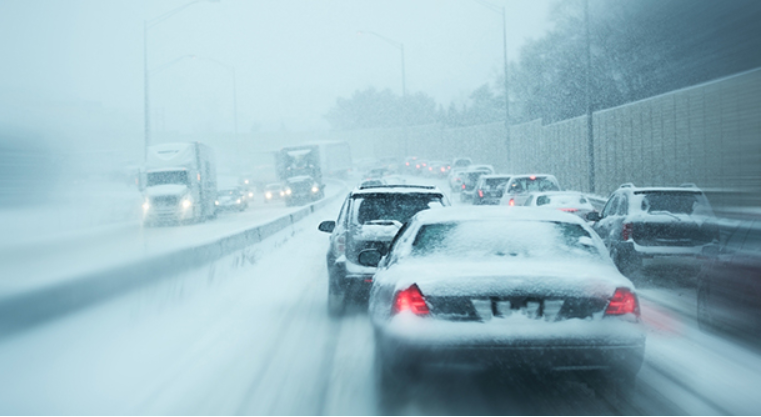Dangerous winter storms, bad weather and sloppy road conditions are a factor in nearly half a million crashes and more than 2,000 road deaths every winter, according to the AAA Foundation for Traffic Safety.
The foundation has suggestions for driving and how to prepare in case you get into a winter crash.
— an announcement from AAA Northeast; infographics from AAA Newsroom Web pages
About 46 percent of all crashes involving bad weather take place in the winter. AAA encourages drivers to be vigilant when hitting the road this winter and to always stay prepared by carrying an emergency roadside kit in your vehicle.
“Winter weather is forecast for this weekend, and there are a disproportionate number of crashes this time of year involving bad weather and winter storms,” said Alec Slatky, AAA Northeast director of public and government affairs.
Eversource has safety tips during and after storms:
- If you notice a power line in the road, keep your distance. There is no way to tell if the line is energized or not. Never drive near, under or over a downed power line. Call Eversource and stay away from the hazard until officials make the area safe for everyone.
- Be especially aware that a fallen tree may be touching a power line. In this dangerous situation, power can travel through the tree and into anything the tree is touching, including the ground itself. Make sure to keep your distance and call Eversource.
“Snow and sleet can cause significant safety problems by reducing visibility and making it difficult to safely maneuver or stop, but by being vigilant behind the wheel, motorists can help to reduce the number of crashes and fatalities.”
A research report by the AAA Foundation analyzed bad weather and crashes over a five-year period. The study found that the highest proportion of crashes involving bad weather happens overnight from 6 p.m. until 5:59 a.m., when visibility is limited and roads are most likely to freeze.
From a 2016 AAA news release:
- “The study did uncover surprising news. Crashes in bad weather are generally less severe than crashes taking place in clear weather. For example, crashes that occur on snow-covered roads result in 31 percent fewer injuries per crash and 47 percent fewer fatalities per crash than on dry roads.
- “While the new study was unable to examine the impact of bad weather on the risk of being involved in a crash in the first place, other studies have found that rates of all types of crashes generally increase in bad weather, but that the increases in minor crashes are larger than the increases in more severe crashes.”
Previous AAA Foundation research also found that the rates of fatal crashes are higher during the first snowfall of the year than on subsequent days with snow.
Driving Recommendations
AAA recommends the following tips while driving in snowy and icy conditions:
- DON’T: Stay home. If you really don’t have to go out, don’t. Even if you can drive well in bad weather, it’s better to avoid taking unnecessary risks by venturing out.
- Drive slowly. Always adjust your speed down to account for lower traction when driving on snow or ice.
- Accelerate and decelerate slowly. Apply the gas slowly to regain traction and avoid skids. Don’t try to get moving in a hurry and take time to slow down for a stoplight. Remember: it takes longer to slow down on icy roads.
- Increase your following distance. Allow five to six seconds of following distance between your vehicle and any vehicle in front of you. This space allows you time to stop safely if the other driver brakes suddenly.
- Know your brakes. Whether you have antilock brakes or not, keep the heel of your foot on the floor and use the ball of your foot to apply firm, steady pressure on the brake pedal. Don’t pump the brakes.
- Don’t stop if you can avoid it. There’s a big difference in the amount of inertia it takes to start moving from a full stop versus how much it takes to get moving while still rolling. If you can slow down enough to keep rolling until a traffic light changes, do it.
- Don’t power up hills. Applying extra gas on snow-covered roads just starts your wheels spinning. Try to get a little inertia going before you reach the hill and let that inertia carry you to the top. As you reach the crest of the hill, reduce your speed and proceed downhill slowly.
- Don’t stop going up a hill. There’s nothing worse than trying to get moving up a hill on an icy road. Get some inertia going on a flat roadway before you take on the hill.
— The AAA has more winter driving tips and tips for driving in snow here.
Prepare — Have an Emergency Kit
“More than 40 percent of motorists do not carry an emergency kit in their vehicle,” said Slatky. “Drivers attempting to brave bad weather should remain cautious and always be prepared by packing an emergency roadside kit.”
AAA recommends always keeping the following items in your “emergency kit” for winter driving:
- Mobile phone and car charger
- First-aid kit
- Blankets
- Drinking water/snacks for everyone in the car including pets
- Flashlight with extra batteries
- Rags, paper towels or pre-moistened wipes
- Basic toolkit including duct tape and warning devices such as flares or reflectors
- Ice scraper/snow brush
- Jumper cables/jump pack
- Traction aid such as sand, salt or non-clumping cat litter
- Tarp, raincoat and gloves
- Shovel

What the AAA Offers
Before hitting the road, drivers can download the free AAA Mobile app for iPhone, iPad and Android. They can use the app to map a route, find AAA Approved Auto Repair facilities and more.
For members in need of roadside assistance, they can use the app, visit AAA.com or call 1-800-AAA-HELP. For added convenience, Wazers can now request AAA roadside assistance directly from the Waze app by tapping the Report menu.
Darienite.com editor’s note: And while were on the subject of driving in winter, here are two other AAA infographics that we thought might be of interest:



